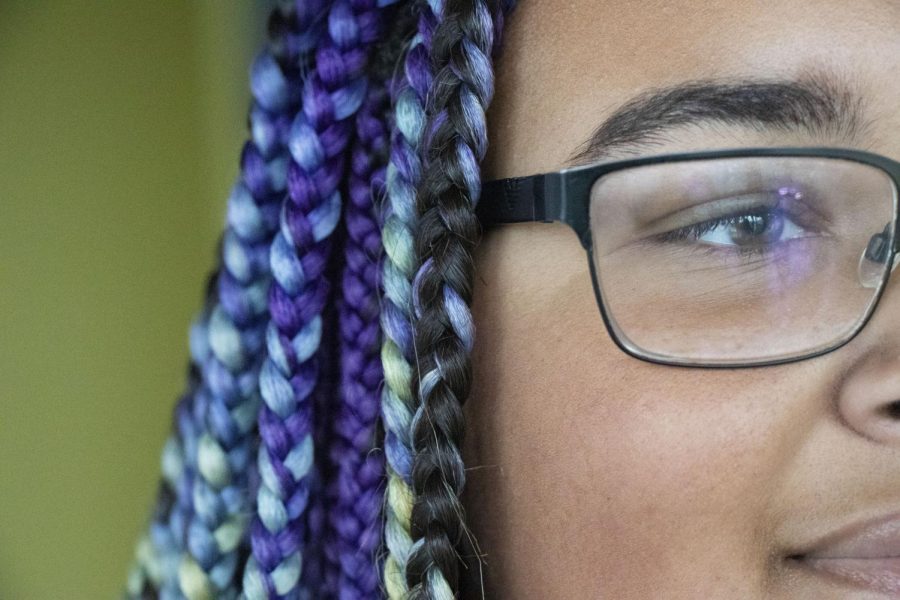Relaxed Dress Code at IHS Gives Students Freedom
COLORFUL AND CONFIDENT Sophomore Desitiny Callendar shows her personal style with colorful braids. Teens at Issaquah expressed their opinions about school dress code versus free dress, and share their feelings about the use of school uniforms.
October 2, 2019
We did not have a say in what we wore until we grew older and developed two primary skills: the ability to think independently and form our own opinions. But what happens when we are restricted to what we are able to wear? When we already have our own opinions on the subject, is it right for someone to tell us what is right versus what is wrong? Here inlies the issue of a dress code. Most schools in the country have some form of a dress code; this set of rules or guidelines may vary from school to school but all have the same purpose. According to FindLaw, school boards make dress code rules for students in order to “promote a safe, disciplined school environment, prevent interference with schoolwork and discipline, and to encourage uniformity of students dress.” Many students have different views on the role dress codes play in a school setting, especially compared to what the school board or higher officials in education may think. Sophomore Mollie Ohrt felt strongly against dress codes viewed them as a violation of one’s freedom of expression. She says, “I feel really violated when people tell me what I can and can’t wear. Personally, I feel kind of uncomfortable because it makes me think that other people are looking at me in a way I don’t want them to be looking at me, and it kind of just makes me think okay, so if people are kind of objectifying me, I need to fix that and they don’t need to fix their point of view.”
Not only did students view these restrictions as a violation of their rights but also as a restraint that was gated more towards regulating what females were wearing compared to the male students. Senior Morgan Bush sees evidence of this and says, “I don’t see a lot of boys being dress coded. It’s mainly targeted towards girls, which sort of exploits them in a way.” Senior Julianna Hiaro also noticed these discrepancies of the double standard for males and females. Hiaro says, “It’s a little sexist, it’s a little like, oh guys can’t control themselves, so girls, you know what, you’re going to suffer.” Male students like senior Jayden Mendoza even admitted, “I mean there’s not really a dress code for males.” When asked if schools should have a dress code, Mendoza replied, “No, because it limits the freedom of expression. It’s kind of bias and pointed more towards one gender.”
When talking about clothing in a school environment, the term ‘uniforms’ tends to always come up. Pros of uniform dressing in a school setting can be unity, less judgement of others based on what they wear, and saving money. Senior Andrew Bayles says, “I feel like we have a sort of freedom without having a uniform, but at the same time, uniforms are also kinda nice because it’s like you know some people judge each other based on clothes. So if everyone is wearing the same thing, it’s like you can’t really judge anyone.” Sophomore Aidan Ruppert on the other hand had a different view. He says, “Uniforms at times seem preppy and fancy and stuff, but I would prefer and I am glad I am able to wear whatever I want whenever I want.” Freshman Courtney Meiring, who had experienced a school setting with uniforms first-hand at her old school, says, “I actually wore a school uniform, so I feel they are very restricting to a person’s personality and choice of what they want to wear. And they were often quite uncomfortable. You could feel very self conscious in them and that’s why it’s so nice being in this school and that I can wear whatever I want.” Teens were able to see some possible benefits of a uniform but the freedom to dress themselves outweighed any of the pros.
Students had similar answers in which they believed with common sense and just a few boundaries or guidelines determining appropriate clothing and not a specific lengthy and detailed code, as young adults, they could definitely dress themselves appropriately for school. Junior Alec Barron answers, “Yes, I mean, I think most people know right from wrong and a lot of the people that do break dress code do [so] by a wide margin. So little violations [that] break the code aren’t terribly noticeable.” Even younger students like freshman Aiden Mendez replies with a similar answer, saying, “Yes, I think [students] know what’s appropriate [and] not.’’ When asked if adults might have a similar answer to the question as he says, “I don’t know, they were born in a different time, so they don’t really wear like all that.”
As young adults, we are coming of age to the point where we are making bigger life decisions every day, from choosing to study for a test to picking out what colleges we are going to apply to. For those decisions, the sky is the limit, but we cannot say the same for other dilemmas like choosing what we are able to wear to school.The institution of having no dress code policy at Issaquah High School has allowed students to express not only their personality but also their beliefs and ideas. Many students are grateful for this chance that not all high schoolers may get. By not being limited, teens at Issaquah are able to be confident in what they wear and not feel restricted in their clothes and as a person. Students realize the hardships others go through by having a strict dress code on a daily basis and are more appreciative that they have a freedom that can sometimes be taken advantage of. They also acknowledge the benefits of having a uniform as it may save time getting ready in the morning and prevent judgements based on wealth. It can also make the student feel like they are apart of something bigger than themselves by having that commonality between them and others their age. The bottom line is we are old enough and have enough common sense to know what is and is not appropriate to wear at school, and I am thankful that the school board believes that, too.




